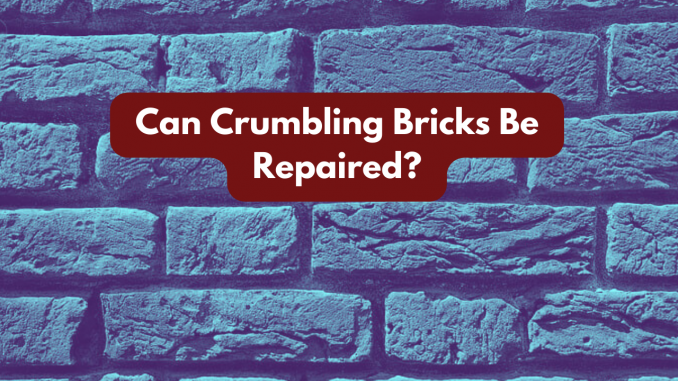
Crumbling bricks are bricks that have deteriorated to the point where they are breaking apart or disintegrating. This deterioration can manifest in various ways, such as cracks, chips, or the complete crumbling of the brick’s surface.
Crumbling bricks can be caused by factors such as water damage, poor construction, age and wear, chemical damage, biological growth, and structural movement. Crumbling bricks can indeed be repaired, but the specific method depends on the extent of the damage. Repairing crumbling bricks often involves cleaning the affected area, repointing mortar joints, replacing damaged bricks, applying sealant, using brick patching compounds, or seeking professional restoration services, depending on the extent of the damage.
Repairing Crumbling Bricks
Cleaning: Before repairing, it’s important to clean the area thoroughly to remove any loose debris, dirt, or grime. This allows for better adhesion of repair materials.
Repointing: Repointing involves removing deteriorated mortar joints and replacing them with fresh mortar. This helps to strengthen the structure and prevent further deterioration.
Replacing Damaged Bricks: If the bricks are severely damaged, they may need to be replaced entirely. Carefully remove the damaged bricks and install new ones in their place. Make sure the new bricks match the existing ones in size, colour, and texture.
Applying Sealant: After the repairs are complete, applying a sealant or waterproofing solution can help protect the bricks from future damage caused by moisture, weathering, or other environmental factors.
Brick Patching Compounds: There are specialised brick patching compounds available that can be used to fill in cracks and holes in bricks. These compounds are typically formulated to bond well with the brick surface and provide a durable repair.
Brick Restoration Services: For extensive damage or historical preservation projects, hiring a professional brick restoration service may be necessary. These professionals have the expertise and tools to repair and restore even the most deteriorated brick structures.
It’s important to assess the extent of the damage and choose the appropriate repair method based on the specific situation. In some cases, consulting with a professional contractor or mason may be necessary to ensure the repairs are done correctly and effectively.
What Causes Crumbling Bricks
Understanding the underlying causes of crumbling bricks, or spalling bricks, is crucial for implementing effective repair and prevention strategies. These causes include:
Water Damage: Water penetration through cracks or porous areas weakens the bricks and mortar joints, leading to erosion and eventual crumbling. Freeze-thaw cycles exacerbate this process.
Poor Construction: Improper laying of bricks or low-quality materials can result in weak mortar joints, inadequate bonding, or improper curing, all of which contribute to premature deterioration.
Age and Wear: Bricks naturally deteriorate over time due to exposure to the elements and regular wear and tear, making them more susceptible to crumbling.
Chemical Damage: Exposure to harsh chemicals like acid rain or air pollutants accelerates brick deterioration, weakening their structure and causing them to crumble.
Biological Growth: Moss, algae, and other organisms trap moisture against brick surfaces, accelerating decay and promoting the growth of damaging microorganisms.
Structural Movement: Shifting or settling of the underlying structure stresses bricks and mortar joints, leading to cracking and crumbling, particularly in older buildings or structures on unstable soil.
Identifying and addressing these issues is essential to prolonging the life of brick structures and preventing further deterioration.

Leave a Reply